Effect of Solidification Direction on the Freckle Formation in Single-Crystal Superalloy Castings
Abstract
1. Introduction
2. Experiment and Simulation
2.1. Solidification Experiment of a Superalloy
2.2. In Situ Solidification Experiments of a Ga-30 wt.% In Alloy
2.3. Simulation of Superalloy Solidification
3. Experimental Results and Discussion
3.1. Directional Solidification Experiments of Superalloy
3.2. Result of In Situ Solidification Experiments
4. Results and Discussion of Simulation Work
5. Conclusions
- (1)
- During the conventional upward solidification of superalloy CMSX-4, severe freckles occurred on the castings of various shapes. In contrast, freckle-free castings were obtained simply by changing the solidification direction from upward to downward.
- (2)
- To visually verify the effect of solidification direction, in situ observation experiments of bidirectional solidification were performed using a Ga-In alloy. In the upward-solidification process, strong solutal convection was visually observed due to the decrease in the interdendritic liquid density. On the other hand, a convection-free state was achieved during downward solidification, because of the stable state under the top-light and bottom-heavy conditions.
- (3)
- A new Rayleigh-number model was successfully applied to characterize the freckle features in superalloy cluster castings. When the solidification direction changed from upward to downward, the driving force for solutal convection was predicted to change from positive to negative. In this case, an absolutely stable state in the melt was established, leading to the complete avoidance of freckle formation in single-crystal superalloy castings.
- (4)
- Based on the result of this work, the downward solidification process should be further applied to the production research of large superalloy components, which is even more important because they are more prone to freckle defects and cannot be avoided by conventional methods.
Author Contributions
Funding
Institutional Review Board Statement
Informed Consent Statement
Data Availability Statement
Conflicts of Interest
References
- Meetham, G.W. The Development of Gas Turbine Materials; Applied Science Publishers: London, UK, 1981; pp. 89–119. [Google Scholar]
- Mclean, M. Directionally Solidified Materials for High Temperature Service; The Metals Society: London, UK, 1983; pp. 1–346. [Google Scholar]
- Donachie, M.J.; Donachie, S.J. Superalloys: A Technical Guide; ASM International: Materials Park, OH, USA, 2002; pp. 11–25. [Google Scholar]
- Reed, R.C. The Superalloys: Fundamentals and Applications; Cambridge University Press: Cambridge, UK, 2008; pp. 1–216. [Google Scholar]
- Nickel-Based Superalloys Market Size, Share & Trends Analysis Report. Available online: https://www.grandviewresearch.com/industry-analysis/nickel-based-superalloys-market (accessed on 15 November 2024).
- Versnyder, F.I.; Shank, M.E. The development of columnar grain and single crystal high temperature materials through directional solidification. Mater. Sci. Eng. 1970, 6, 213–247. [Google Scholar] [CrossRef]
- Pratt, D.C. Industrial Casting of Superalloys. Mater. Sci. Technol. 1986, 2, 426–435. [Google Scholar] [CrossRef]
- Quested, P.N.; Osgerby, S. Mechanical properties of conventionally cast, directionally solidified, and single-crystal superalloys. Mater. Sci. Technol. 1986, 2, 461–475. [Google Scholar] [CrossRef]
- Pollock, T.M.; Tin, S. Nickel-based superalloys for advanced turbine engines: Chemistry, microstructure and properties. J. Propuls. Power 2006, 22, 361–374. [Google Scholar] [CrossRef]
- Giamei, A.; Tschinkel, J. Liquid metal cooling: A new solidification technique. Metall. Trans. A 1976, 7, 1427–1434. [Google Scholar] [CrossRef]
- Giamei, A.F.; Kear, B. On the nature of freckles in nickel base superalloys. Metall. Trans. 1970, 1, 2185–2192. [Google Scholar] [CrossRef]
- Copley, S.; Giamei, A.F.; Johnson, S.; Hornbecker, M.F. The origin of freckles in unidirectionally solidified castings. Metall. Trans. 1970, 1, 2193–2204. [Google Scholar] [CrossRef]
- Auburtin, P.; Wang, T.; Cockcroft, S.; Mitchell, A. Freckle formation and freckle criterion in superalloy castings. Metall. Mater. Trans. B 2000, 31, 801–811. [Google Scholar] [CrossRef]
- Tin, S.; Pollock, T. Predicting freckle formation in single crystal Ni-base superalloys. J. Mater. Sci. 2004, 39, 7199–7205. [Google Scholar] [CrossRef]
- Auburtin, P.B.L. Determination of the Influence of Growth Front Angle on Freckle Formation in Superalloys. Ph.D. Thesis, University of British Columbia, Vancouver, BC, Canada, 1998. [Google Scholar]
- Auburtin, P.; Cockcroft, S.; Mitchell, A. Liquid density inversions during the solidification of superalloys and their relationship to freckle formation in castings. Superalloys 1996, 443–450. [Google Scholar] [CrossRef]
- Ren, N.; Li, J.; Panwisawas, C.; Xia, M.; Li, J. Thermal-solutal-fluid flow of channel segregation during directional solidification of single-crystal nickel-based superalloys. Acta Mater. 2021, 206, 116620. [Google Scholar] [CrossRef]
- Ren, N.; Panwisawas, C.; Li, J.; Xia, M.; Dong, H.; Li, J. Solute enrichment induced dendritic fragmentation in directional solidification of nickel-based superalloys. Acta Mater. 2021, 215, 117043. [Google Scholar]
- Ren, N.; Li, J.; Panwisawas, C.; Xia, M.; Dong, H.; Li, J. Insight into the sensitivities of freckles in the directional solidification of single-crystal turbine blades. J. Manuf. Process. 2022, 77, 219–228. [Google Scholar]
- Szeliga, D. Reduction of freckle defect in single-crystal blade root by controlling local cooling conditions. Metall. Mater. Trans. A 2022, 53, 3224–3231. [Google Scholar] [CrossRef]
- Wang, Z.; Li, J.; Liu, S.; Wang, X.; Yang, W. Effects of Withdrawal Velocity and Casting Geometry on Freckle Formation of Nickel-Based Single Crystal Superalloys. Metall. Mater. Trans. A 2023, 54, 1223–1235. [Google Scholar]
- Ma, D.X.; Wu, Q.; Bührig-Polaczek, A. Some new observations on freckle formation in directionally solidified superalloy components. Metall. Mater. Trans. B 2012, 43, 344–353. [Google Scholar]
- Ma, D.X.; Bührig-Polaczek, A. The geometry effect on freckle formation in the directionally solidified superalloy CMSX-4. Metall. Mater. Trans. A 2014, 45, 1435–1444. [Google Scholar] [CrossRef]
- Ma, D.; Zhao, Y.; Xu, W. Freckle Formation Affected by Geometry Features of Single Crystal Superalloy Castings. Res. Dev. Mater. Sci. 2021, 15, 1749–1752. [Google Scholar]
- Han, D.; Jiang, W.; Han, X.; Li, K.; Lu, Y.; Lou, L. Influence of geometric structure and feeding behavior of casting on freckle formation during directional solidification of a Ni-based single-crystal superalloy. Cryst. Res. Technol. 2021, 56, 2000197. [Google Scholar] [CrossRef]
- Wang, Z.; Li, J.; Liu, S.; Zhao, J.; Wang, X.; Yang, W. Investigation on freckle formation of nickel-based single crystal superalloy specimens with suddenly reduced cross section. J. Alloys Compd. 2022, 918, 165631. [Google Scholar] [CrossRef]
- Pustal, B.; Wittenzellner, T.; Behnken, H.; Böttger, B.; Bührig-Polaczek, A. Experimental Analysis and Simulation of Freckle Formation at Different Edge Angles During Directional Solidification of Ni-Base Superalloys. Metall. Mater. Trans. B 2024, 55, 2732–2738. [Google Scholar] [CrossRef]
- Nguyen-Thi, H.; Salvo, L.; Mathiesen, R.H.; Arnberg, L.; Billia, B.; Suery, M.; Reinhart, G. On the interest of synchrotron X-ray imaging for the study of solidification in metallic alloys. Comptes Rendus Phys. 2012, 13, 237–245. [Google Scholar]
- Boden, S.; Eckert, S.; Willers, B.; Gerbeth, G. X-ray radioscopic visualization of the solutal convection during solidification of a Ga-30 Wt Pct in alloy. Metall. Mater. Trans. A 2008, 39, 613–623. [Google Scholar] [CrossRef]
- Saad, A.; Gandin, C.-A.; Bellet, M.; Shevchenko, N.; Eckert, S. Simulation of channel segregation during directional solidification of In—75 wt pct Ga. Qualitative comparison with in situ observations. Metall. Mater. Trans. A 2015, 46, 4886–4897. [Google Scholar] [CrossRef]
- Karagadde, S.; Yuan, L.; Shevchenko, N.; Eckert, S.; Lee, P.D. 3-D microstructural model of freckle formation validated using in situ experiments. Acta Mater. 2014, 79, 168–180. [Google Scholar]
- Shevchenko, N.; Roshchupkina, O.; Sokolova, O.; Eckert, S. The effect of natural and forced melt convection on dendritic solidification in Ga–In alloys. J. Cryst. Growth 2015, 417, 1–8. [Google Scholar]
- Reinhart, G.; Grange, D.; Abou-Khalil, L.; Mangelinck-Noël, N.; Niane, N.T.; Maguin, V.; Guillemot, G.; Gandin, C.-A.; Nguyen-Thi, H. Impact of solute flow during directional solidification of a Ni-based alloy: In-situ and real-time X-radiography. Acta Mater. 2020, 194, 68–79. [Google Scholar]
- Sharp, D.H. An overview of Rayleigh-Taylor instability. Phys. D Nonlinear Phenom. 1984, 12, 3–18. [Google Scholar]
- Worster, M.G. Instabilities of the liquid and mushy regions during solidification of alloys. J. Fluid Mech. 1992, 237, 649–669. [Google Scholar]
- Beckermann, C.; Gu, J.; Boettinger, W.J. Development of a freckle predictor via Rayleigh number method for single-crystal nickel-base superalloy castings. Metall. Mater. Trans. A 2000, 31, 2545–2557. [Google Scholar]
- Yang, W.; Chang, K.-M.; Chen, W.; Mannan, S.; DeBarbadillo, J. Freckle criteria for the upward directional solidification of alloys. Metall. Mater. Trans. A 2001, 32, 397–406. [Google Scholar] [CrossRef]
- Tewari, S.N.; Tiwari, R.; Magadi, G. Mushy-zone Rayleigh number to describe macrosegregation and channel segregate formation during directional solidification of metallic alloys. Metall. Mater. Trans. A 2004, 35, 2927–2934. [Google Scholar] [CrossRef][Green Version]
- Liu, Y.; Wang, F.; Ma, D.; Yang, Q.; Xu, W.; Zhao, Y.; Dong, H.; Liu, Y.; Li, D. Freckle prediction model incorporating geometrical effects for Ni-based single-crystal superalloy components. Acta Mater. 2024, 266, 119702. [Google Scholar] [CrossRef]
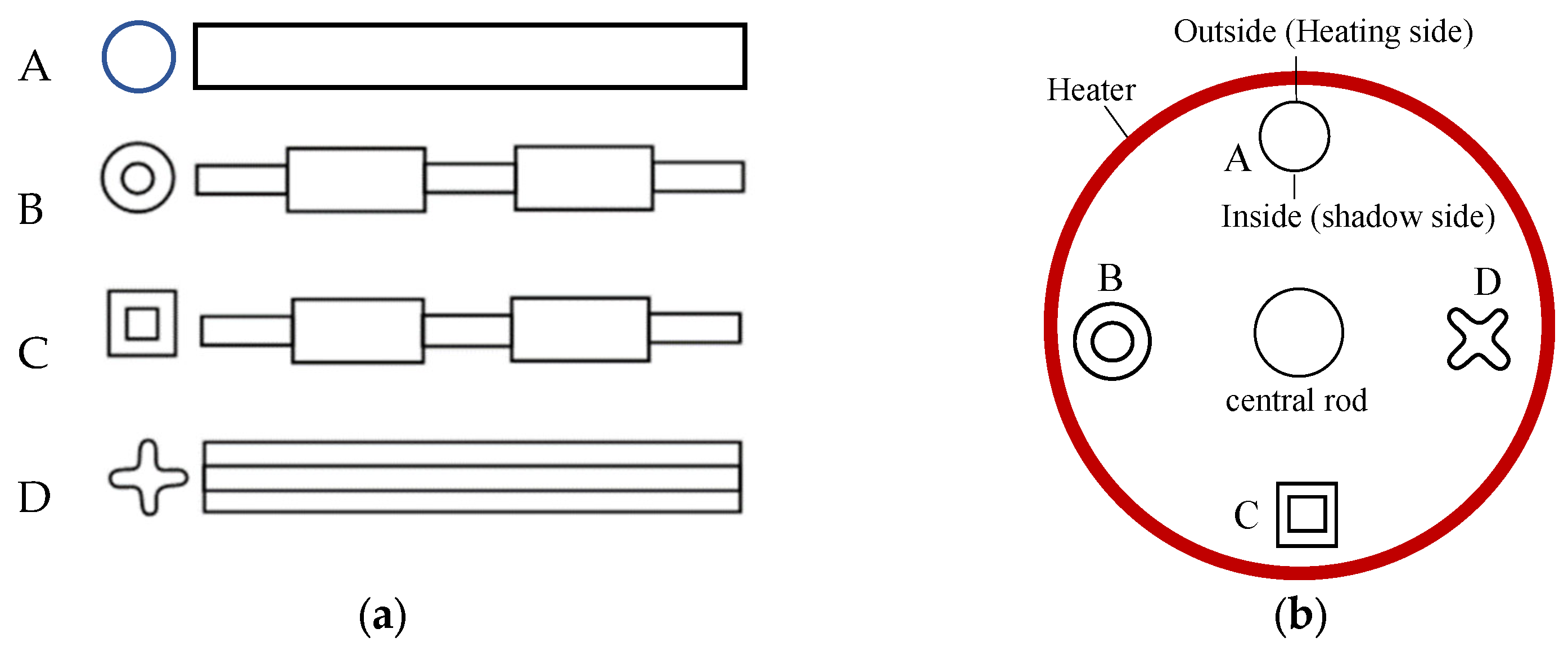

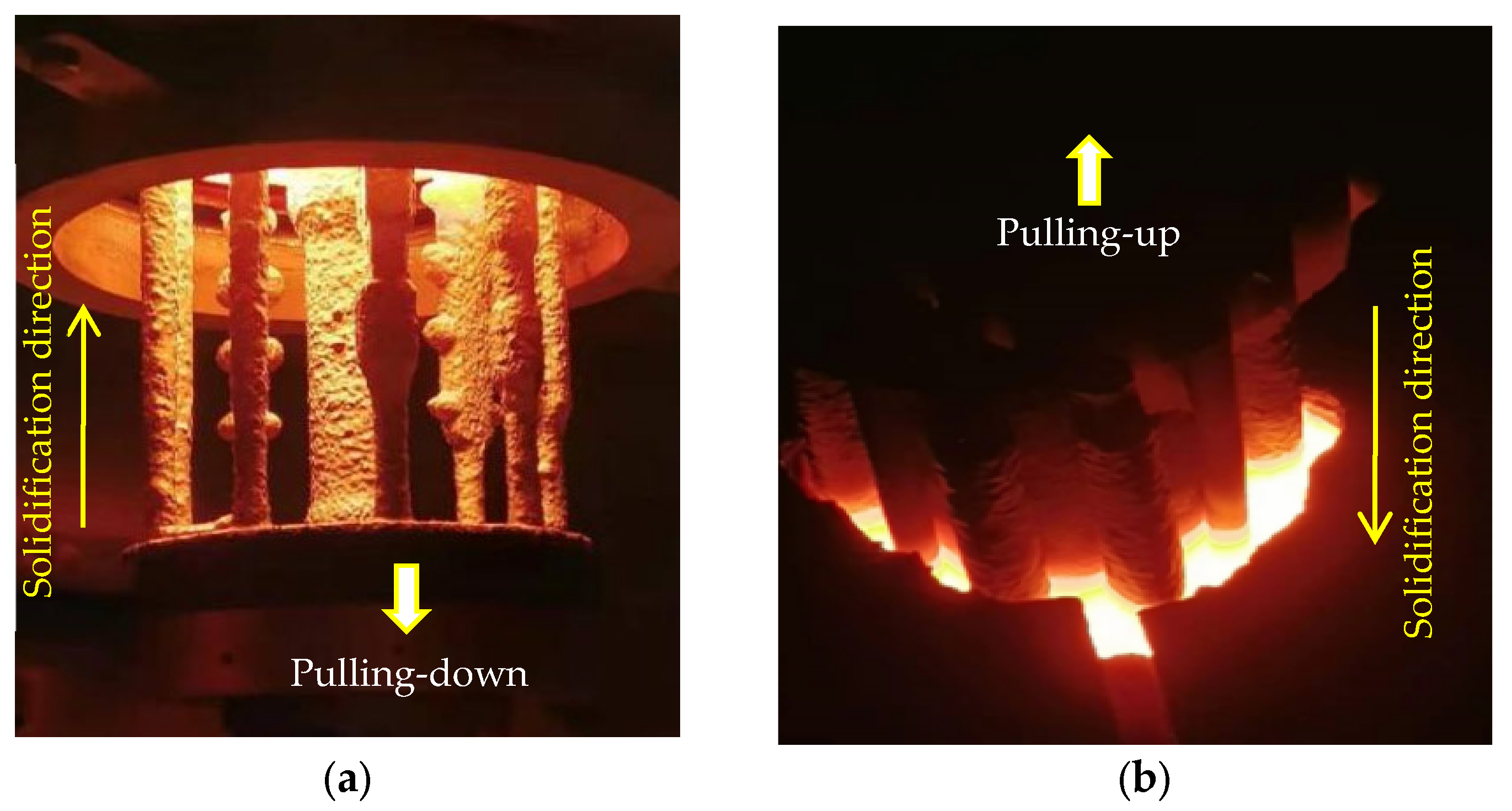

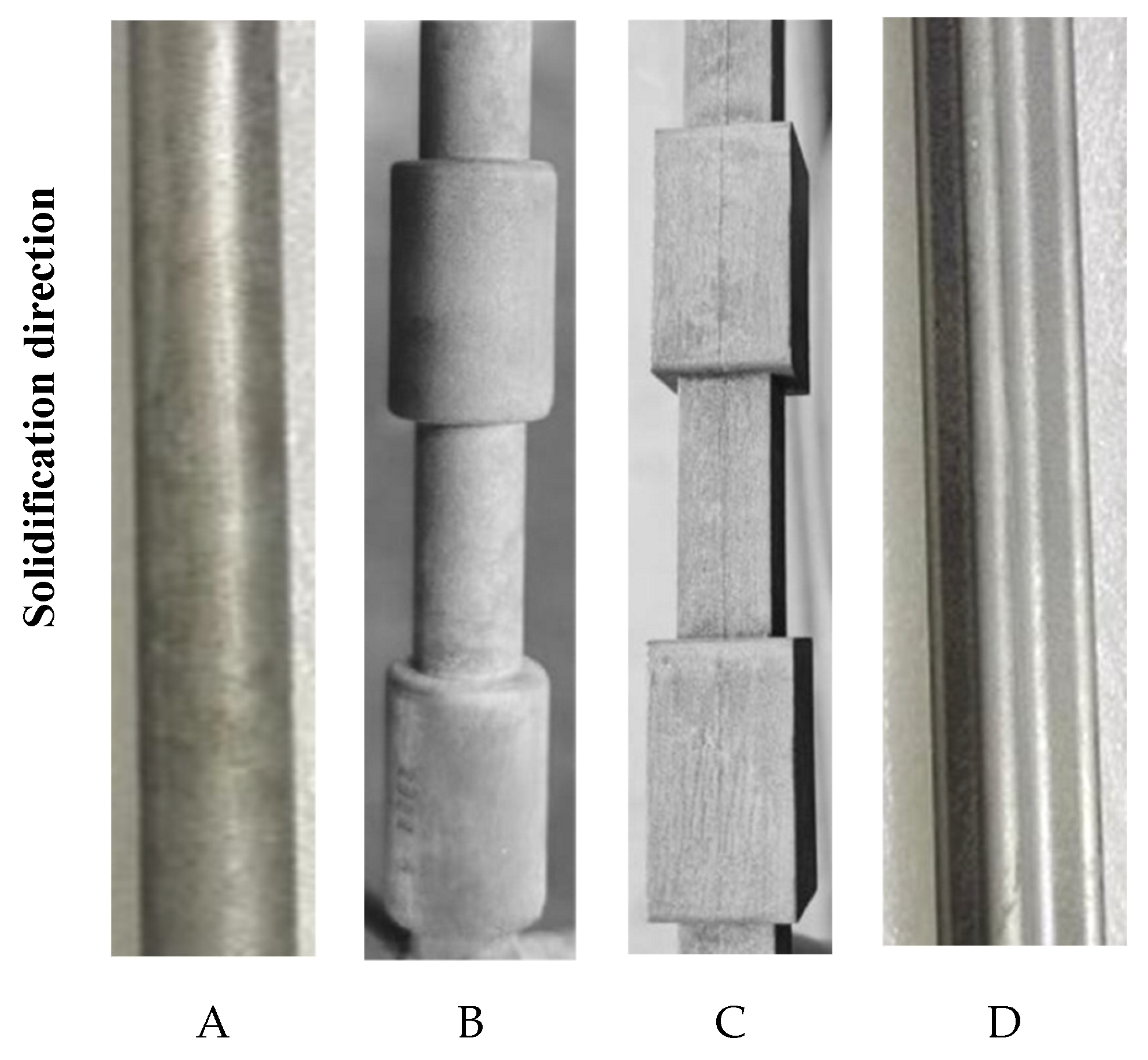
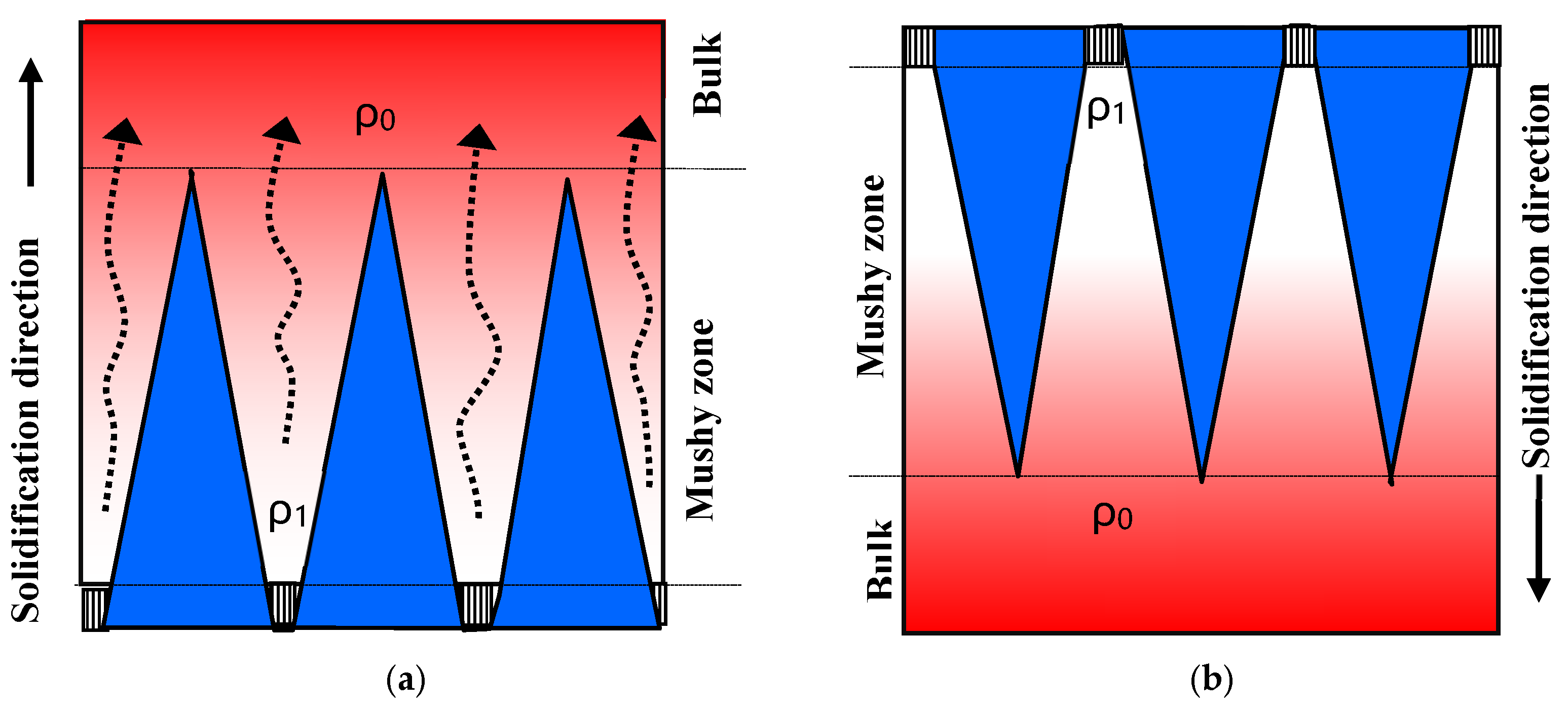

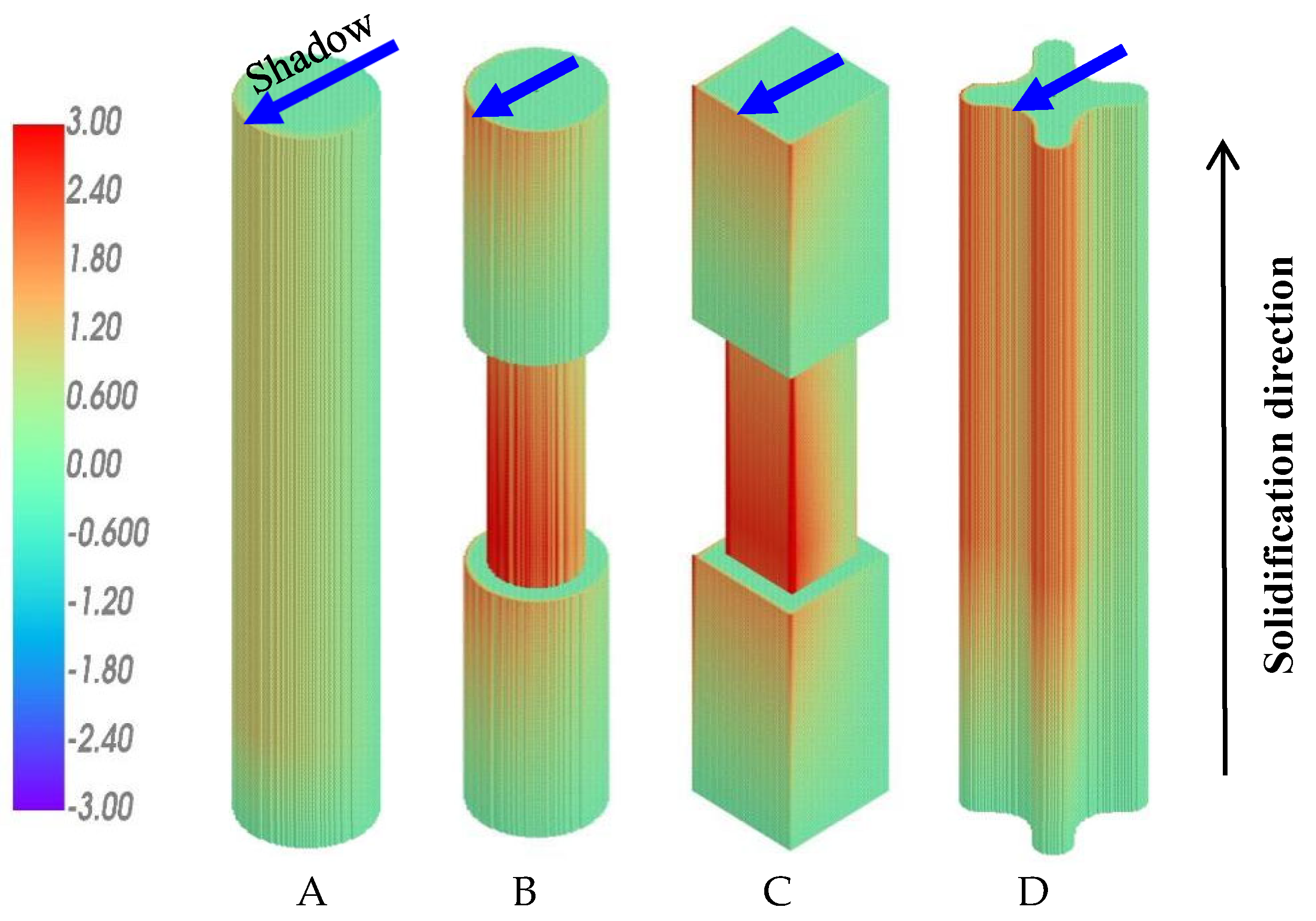

| Cr | Co | W | Mo | Al | Ti | Ta | Re | Hf | Ni |
|---|---|---|---|---|---|---|---|---|---|
| 6.5 | 9.0 | 6.0 | 0.6 | 5.6 | 1.0 | 6.5 | 3.0 | 0.1 | Bal. |
Disclaimer/Publisher’s Note: The statements, opinions and data contained in all publications are solely those of the individual author(s) and contributor(s) and not of MDPI and/or the editor(s). MDPI and/or the editor(s) disclaim responsibility for any injury to people or property resulting from any ideas, methods, instructions or products referred to in the content. |
© 2025 by the authors. Licensee MDPI, Basel, Switzerland. This article is an open access article distributed under the terms and conditions of the Creative Commons Attribution (CC BY) license (https://creativecommons.org/licenses/by/4.0/).
Share and Cite
Ma, D.; Sun, H.; Zhao, Y.; Xu, W.; Huang, Z.; Cheng, B.; Liu, Y.; Wang, F.; Yang, Q.; Li, L.; et al. Effect of Solidification Direction on the Freckle Formation in Single-Crystal Superalloy Castings. Materials 2025, 18, 1534. https://doi.org/10.3390/ma18071534
Ma D, Sun H, Zhao Y, Xu W, Huang Z, Cheng B, Liu Y, Wang F, Yang Q, Li L, et al. Effect of Solidification Direction on the Freckle Formation in Single-Crystal Superalloy Castings. Materials. 2025; 18(7):1534. https://doi.org/10.3390/ma18071534
Chicago/Turabian StyleMa, Dexin, Hongyuan Sun, Yunxing Zhao, Weitai Xu, Zaiwang Huang, Bowen Cheng, Yang Liu, Fu Wang, Qiang Yang, Lv Li, and et al. 2025. "Effect of Solidification Direction on the Freckle Formation in Single-Crystal Superalloy Castings" Materials 18, no. 7: 1534. https://doi.org/10.3390/ma18071534
APA StyleMa, D., Sun, H., Zhao, Y., Xu, W., Huang, Z., Cheng, B., Liu, Y., Wang, F., Yang, Q., Li, L., Deng, Y., Xu, F., Zhang, H., & Wu, M. (2025). Effect of Solidification Direction on the Freckle Formation in Single-Crystal Superalloy Castings. Materials, 18(7), 1534. https://doi.org/10.3390/ma18071534










